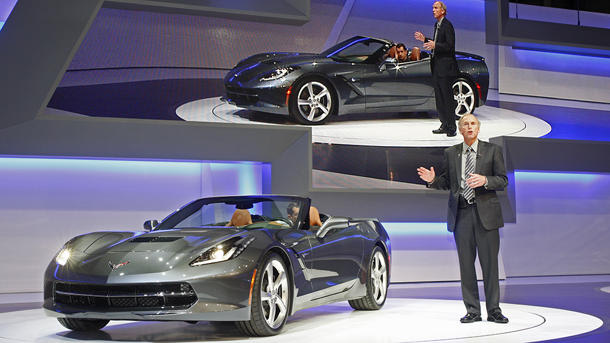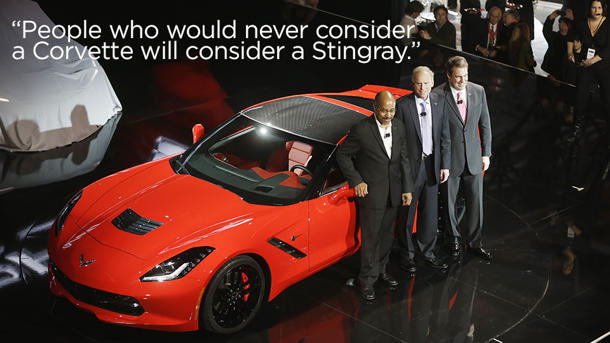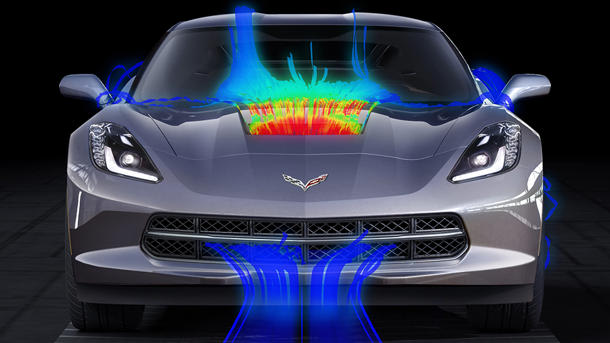In the six decades Chevrolet has built the Corvette, only five men have served as its chief engineer. None have overseen a transformation quite like the one current chief Tadge Juechter engineered for that the 2014 Corvette Stingray, mixing the traditional idea of a low-slung, V-8-powered sports car with the newest technology available. In this interview at the New York auto show — using questions solicited from Motoramic readers online — Juechter reveals the drive behind the controversial design changes, the engine that his team passed up and the new bit of NASA technology now baked into every car.
When the new Vette was revealed, the tail lights got a lot of attention...
More on the Internet than in person. I've been standing around this car for a couple of months now, in this case today side-by-side with a Camaro. People who see them in person say "this is pretty cool," espeically when they're lit up, especially outside. They're very three-dimensional, very jewel-like.
Live, I don't hear the complaints. The Internet can boil over with people chiming in. Until you've see the car in person...it's just so much noise. We got rid of pop up headlamps on the C6, and it was the end of the world. How could you get rid of pop-up headlamps? They got over it in a hurry.
How much debate was there internally over the change?
We knew we wanted to do something different. When we cliniced customers, especially on the coasts — because even though we're the best-selling sports car, we underperform relative to the nationwide average, and we'd like to do better on the coasts — one of the proof points for people was they felt the Corvette had not changed, all the way from the C4, they felt it hadn't been upgraded. Knowledgeable car people knew the car had major upgrades, but it didn't get on people's radar screens because every time they pulled up behind a Corvette they saw what looked to them ... they brought pictures of a C4, C5, C6, and said it's old tech, it's the same Corvette from my youth, it's not very sophisticated, you haven't changed it. That's why we felt comfortable walking away a little bit from what we've done, traditionally. The big debate was how far do you walk away.
We're spending a lot of money on LEDs. They're great when you have a car that can set magazine records for braking distances -- that fraction of a second counts. We're could have made these LEDs look like traditional Corvette incadescent lamps, which are very light and very cheap.
In the end, we took a risk. You look at the whole car, and the resulting impression of the whole car is "wow, this thing is new." It's a Stingray now. The feedback we're getting now is people who would never consider a Corvette will consider a Stingray.
Has the Stingray gone around the Nürburgring?
No. That's the last thing we do. We do all our development testing here, at Milford. We go to Road Atlanta and VIR (Virginia International Raceway), a whole bunch of different tracks. The last thing we do is go to Nurburgring. Other people make a much bigger deal out of the Ring than we do. If we go every couple of years, that's a big deal for us. We don't go for fast laps. We go for chassis development, tuning, making sure the car is hardened to that track, so you have no failures...and if we have time, which we almost never do, we'll get one or two fast laps in at the end of the day. We did one lap on the Z06 to set the 7:22, and two laps in the ZR1 to set the 7:19. Other people rent the track and get Formula 1 level drivers and, you know, whatever it takes. It's a corporate mission to post a lap time. For us, it's not a corporate mission.
We just saw the new Cadillac CTS with a 420-hp twin-turbo V-6. Would you consider using it in the Corvette?
We did look at it, but we rejected it for a bunch of reasons. One is we get more power out of this. If you're going to do a V-6 turbo, you want to architect the car around a V-6 turbo, and then what do you do for any future uplevels should we decide to do those? What are you going to do? Boost it more? It's a perfectly fine engine, and a good application (in the CTS).
We also talked with customers and it's tough to find a customer willing to give up his V-8 for a V-6. Once you've been imprinted on the V-8 sound, rumble, feel, immediate responsiveness of low-end torque...we've found the best balance for us is still a V-8, (and) run it in 4-cylinder mode as much as you can to get fuel economy.
What's the response to the idea there could be a sub-Stingray model Corvette?
It's a load of crap. It's fabricated.
Alright, moving along. Do you have a timetable for when we would see the more powerful Corvette models?
(smiling) I'm not even going to acknowledge the premise of that question that there are uplevel models coming.
Given the arrival of hypercars like the McLaren P1 and Porsche 918 with hybrid power, do you ever envision a need for a Corvette hybrid?
Hybrids make sense as technology flagships for those folks, like the Porsche 959. It was this groundbreaking, turbo, all-wheel-drive, car...but it was an experiment.
I can understand why manufacturers are doing that kind of car. Our job is to keep the Corvette alive. We don't have the money to spend on that kind of car, and we're trying to do the best car we can. GM is doing on a lot of advanced work on the Volt and (Cadillac) ELR and alternative powertrain, so we have great entry to that technology. I always tell people when it makes a better car, we'll do it. And when I say better, I mean better in every way. Technology has to enhance the driver experience; that's why we spent money on aluminum frames and carbon-fiber panels.
How has computational fluid dynamics changed your job?
We use state of the art CFD developed by (Corvette racing team) Pratt & Miller, and they had to spin it off from the rest of the company because the U.S. government wants to use it in military applications. That's how powerful it is. Racecar stuff and car stuff is easy compared to hyperspeed missiles.
The race guys, they can't rent every track. They can do some test work, but they basically have to go to the track blind, and synthesize the performance of the car on that track. Aerodynamics play such a huge role when you're totally dependent on downforce to make the corner speeds, it has to work. They're almost betting their drivers' lives on the fidelity of the results of that software. It makes a great tool for us to be able to not just predict what's going to happen, but actually synthesize a solution so you can actually in math data, artificially, create a solution and then just validate it on the street. The tools are very powerful, because you can visualize what's happening.
What's the split between manuals and automatics today in Corvettes, and where's it going?
Right now its 40 percent manual, 60 percent automatic. It's a little higher than normal, because Z06 and ZR1 are manual only. In the convertible, where we offer both, it's two-thirds/one-third.
I think it will be 40/60, because the new 7-speed manual transmission, because of the rev matching system, makes the car so fun to drive, and many of our competitors are abandoning traditional three-pedal manuals in favor of paddle shifting...if you want a state-of-the-art 7-speed manual transmission, there aren't a lot of places to go.
What's something that you're proud of in the new Corvette Stingray that you haven't talked about before?
There's a lot of minor technology stories we haven't talked about because we've focused on the big picture stuff. There's a lot under the skin.
One example is that one of the pet peeves people have on today's car...is the center tunnel gets hot. We run the center exhaust down that tunnel, and this car is just as susceptible as the previous car. Aluminum is a great conductor of heat, and now we put our close-out panels below the exhaust, so we're fully containing the exhaust inside the tunnel; there's a potential to make it worse.
We've used Aerogel material — which are if you look them up, developed by NASA for space suits. It's the ultimate insulator...for a long time they were the lightest solids ever developed. We have a company that was able to develop that material into an automotive grade substrate, attach it into a vehicle. If you look behind the carpet, on the sides of the tunnel, we have a 10 mm-thick layer of Aerogel, and we have 5 mm on the top of the tunnel under the top of the tunnel and cupholders. I'm not saying it's going to be cool all the time, but we're using space-suit material to insulate the driver from that heat.
Source: Yahoo!



No comments:
Post a Comment